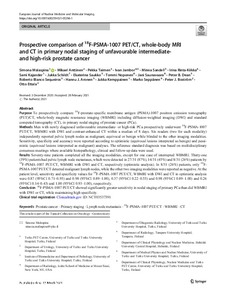Prospective comparison of 18F-PSMA-1007 PET/CT, whole-body MRI and CT in primary nodal staging of unfavourable intermediate- and high-risk prostate cancer
Sandell Minna; Boström Peter J; Kemppainen Jukka; Malaspina Simona; Aronen Hannu J; Kajander Sami; Sequeiros Roberto Blanco; Anttinen Mikael; Noponen Tommi; Saunavaara Jani; Ettala Otto; Schildt Jukka; Dean Peter B; Saukko Ekaterina; Seppänen Marko; Jambor Ivan; Rinta-Kiikka Irina; Taimen Pekka
Prospective comparison of 18F-PSMA-1007 PET/CT, whole-body MRI and CT in primary nodal staging of unfavourable intermediate- and high-risk prostate cancer
Sandell Minna
Boström Peter J
Kemppainen Jukka
Malaspina Simona
Aronen Hannu J
Kajander Sami
Sequeiros Roberto Blanco
Anttinen Mikael
Noponen Tommi
Saunavaara Jani
Ettala Otto
Schildt Jukka
Dean Peter B
Saukko Ekaterina
Seppänen Marko
Jambor Ivan
Rinta-Kiikka Irina
Taimen Pekka
SPRINGER
Julkaisun pysyvä osoite on:
https://urn.fi/URN:NBN:fi-fe2021042825558
https://urn.fi/URN:NBN:fi-fe2021042825558
Tiivistelmä
Purpose To prospectively compare F-18-prostate-specific membrane antigen (PSMA)-1007 positron emission tomography (PET)/CT, whole-body magnetic resonance imaging (WBMRI) including diffusion-weighted imaging (DWI) and standard computed tomography (CT), in primary nodal staging of prostate cancer (PCa).
Methods Men with newly diagnosed unfavourable intermediate- or high-risk PCa prospectively underwent F-18-PSMA-1007 PET/CT, WBMRI with DWI and contrast-enhanced CT within a median of 8 days. Six readers (two for each modality) independently reported pelvic lymph nodes as malignant, equivocal or benign while blinded to the other imaging modalities. Sensitivity, specificity and accuracy were reported according to optimistic (equivocal lesions interpreted as benign) and pessimistic (equivocal lesions interpreted as malignant) analyses. The reference standard diagnosis was based on multidisciplinary consensus meetings where available histopathology, clinical and follow-up data were used.
Results Seventy-nine patients completed all the imaging modalities, except for one case of interrupted WBMRI. Thirty-one (39%) patients had pelvic lymph node metastases, which were detected in 27/31 (87%), 14/31 (45%) and 8/31 (26%) patients by F-18-PSMA-1007 PET/CT, WBMRI with DWI and CT, respectively (optimistic analysis). In 8/31 (26%) patients, only F-18-PSMA-1007 PET/CT detected malignant lymph nodes, while the other two imaging modalities were reported as negative. At the patient level, sensitivity and specificity values for F-18-PSMA-1007 PET/CT, WBMRI with DWI and CT in optimistic analysis were 0.87 (95%CI 0.71-0.95) and 0.98 (95%CI 0.89-1.00), 0.37 (95%CI 0.22-0.55) and 0.98 (95%CI 0.89-1.00) and 0.26 (95%CI 0.14-0.43) and 1.00 (95%CI 0.93-1.00), respectively.
Conclusion F-18-PSMA-1007 PET/CT showed significantly greater sensitivity in nodal staging of primary PCa than did WBMRI with DWI or CT, while maintaining high specificity.
Kokoelmat
- Rinnakkaistallenteet [19218]
